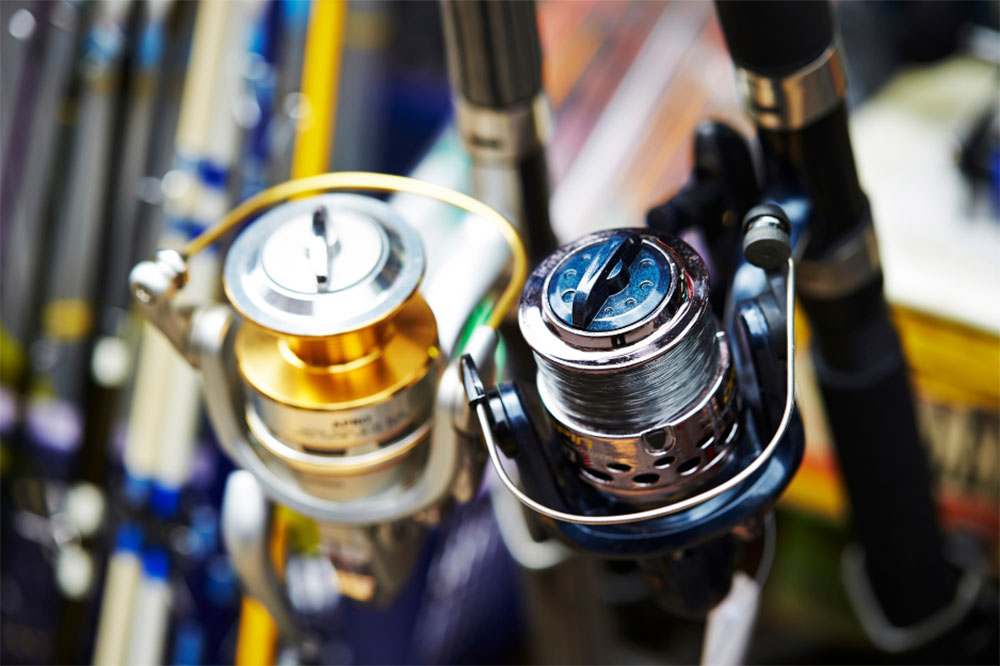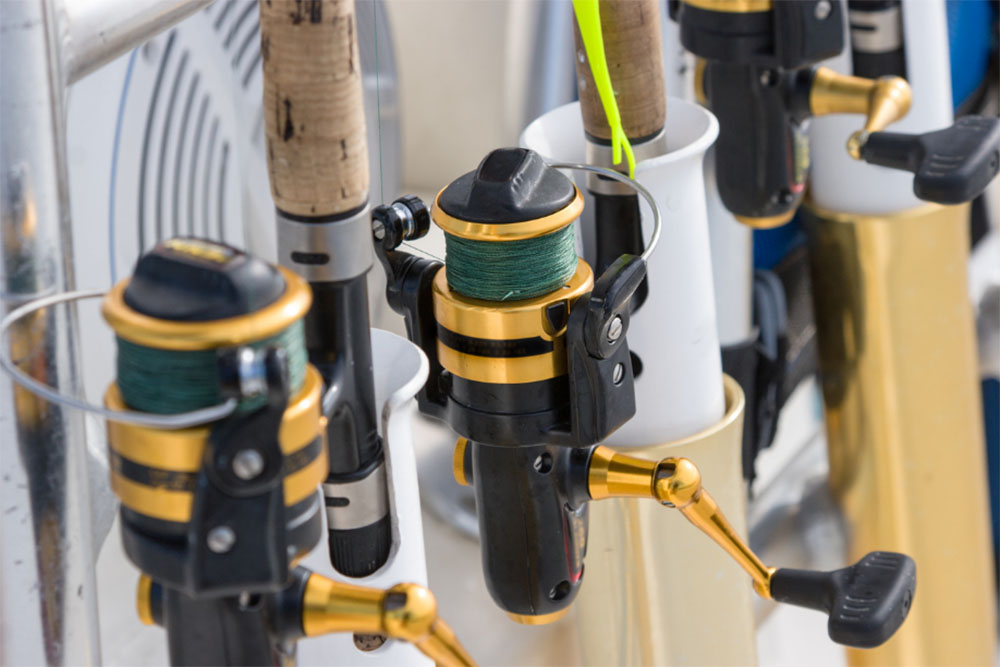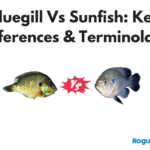When you go into your local angling store, you will find yourself overwhelmed with how many options you have for everything in 2022. There are a plethora of options for everything you could want. Enhancing your fishing experience is the goal of all these options; fishing reels are no different, so you have many choices.
Both beginners and professionals can choose from many available options; spincast, baitcast, trolling, surf reels, and many more. With such variety, how can you choose, this is a hard choice, especially if you are new to all this.

Now, we would like to take the time to compare open and closed-faced fishing reels. What their differences are and where each is best used.
For anyone who is trying to choose between these two very common fishing reel types, we can help. We will look at all their features and focuses and have a little look at their pros and cons.
What is an open-faced fishing reel?
Let’s start with open-faced reels. We want to define these reel types before we get into anything else.
An open-faced reel is also known as a spinning reel; it is widely used. If you pick up one of these, one of the first things you will notice is that the spool and most of the moving parts are open, rather than being behind by a spool cover.
You store your line on the spool, and once you have cast the line and closed the bail arm, it will spot uncoiling.
Several other features characterize this type of reel. An open-face reel has the reel mounted below the rod.
Typically, the handle locks on these reels, which keeps the line from spinning backward and coming off the spool. They also usually include a wire bail that you can use to distance your cast.
There are no rules that prevent beginner anglers from using this type of reel; however, it is best suited to intermediate or experienced anglers.
This is because open-faced fishing reels will require you to use your finger to guide the line as you cast; this is a practice that takes some time to get right, so that it may be frustrating for beginners.
What is a closed-faced fishing reel?
On the opposition, we have closed-faced reels. Unlike open-faced reels, which have exposed lines, you do not see the spool with this type. Instead, the fishing line is enclosed inside the reel’s nose cone and has a hole in it that allows the line to pass through.
Closed-faced reels are also known as spincast reels. A difference between these and spinning reels is that spincast reels are mounted above the handle rather than below.
If you fished in your childhood, you probably used a closed-faced fishing reel simply because of how easy they are to cast; all you need to do with them is press a button that releases the fishing line.
The whole set-up and technique for these are much simpler with spincast reels. It is all about aligning the timing of releasing the line and snapping the rod.
Open Vs. Closed
Now that we know the primary difference between these two reel types, let us look at how they compare and in which areas they are most competent.
Casting
Winner: Closed-Faced
Casting is the area in which these reel types differ excessively. Closed-faced versions are much more accessible. Pretty much anyone of any experience can pick up one of these and successfully cast it since the reel does the work for you, and all you need to do is press a button.
The ease of easing is what makes spincast reels the most popular with beginners and children alike.
While we say this, casting does require a bit more finesse when using an open-faced fishing reel. Most anglers would say that open-faced reels are just as easy to use once you get used to using them.
They just take a bit of getting used to. Some beginners also enjoy and prefer learning to fish with this type of reel too. It’s all about preference.
Casting distance
Winner: Open-faced
If you want to catch some bigger fish, then casting longer distances is crucial. Not all rods are created equally when it comes to being able to cast greater distances.
In the case of greater distances, open-faced reels take the gold. Their open design gives you more room to store more lines on the spool, which is advantageous when cast over greater distances.
Accuracy
Winner: Open-faced
Although they are a bit more fiddly and tricky to use than the closed-faced alternative, a spinning reel gives you a higher degree of accuracy once you have got to grips with how they work.
A novice angler will take time to develop this skill as they learn. But an intermediate or experienced angler will achieve a greater level of accuracy with an open-faced reel.
Backlash
Winner: Neither; open-faced is easier to backlash but easier to fix; closed-face is harder to backlash but harder to fix.
Backlash is a sadly common and frustrating issue that all anglers face. This problem is often called ‘birdnesting.’ It occurs when the lure slows after you have cast the line, but the spool keeps on moving.
While this is most common on a baitcasting reel, it can also happen on a spinning reel. The result of backlash is a heavily tangled line that resembles the messy chaos of a bird’s nest. It will tangle, and you can expect to end up spending precious fishing time fixing it.
Backlash happens under one or two scenarios; when you’re casting into the wind or using a lure that is not quite heavy enough. The line can end up getting tangled around the tip of the rod, or more annoyingly, directly on the spool.
It is much easier for a backlash to occur when you are using an open-faced reel. The best way to avoid this very annoying problem is to practice, refine your technique, and avoid putting too much line onto the spool; doing so can help prevent bird nests.
While closed-faced reels rarely suffer from backlash, spincast reels are not without problems. Anglers who use spincast reels (consider two popular spincast reels, the Zebco Bullet and Omega Pro here) often have to deal with knots and tangles inside the spool housing, which is even more difficult to revolve.

Quality
Winner: Open-faced
One of the areas in which we witness a significant difference between these two-rod types is quality.
There is a clear winner here. The quality of an open-faced reel tends to be much better and more robust. Inferior quality tends to be the downfall of spincast reels; this is also often reflected in the price.
There are plenty of cheap spincast reels available, especially plastic models. But, if you are someone who intends on fishing regularly and consistently, we recommend going with an open-faced reel because even the best spincast reels won’t last you very long if used regularly. Sadly they just are not designed to stand the test of time.
Versatility
Winner: open-faced
Any serious fisher should aim to purchase a reel that provides the most versatility possible.
As you have to use a small spool with a low line capacity, a closed-faced reel will suffer from a lack of flexibility. They are good for a select few things, generally catching small fish in one particular area.
One of the main flaws in the versatility of closed-faced reels is that they do not have much hauling power; you will find it very difficult to yank a big fish out of the water, especially in heavily vegetated areas. If you want to increase your ability to catch fish, then an open-faced reel is much better.
A spinning reel doesn’t offer the exceptional power of something like a baitcasting reel does, so don’t go expecting to haul in a dish that weighs over 50lbs. They are also not suited to salt-water fishing. However, regardless of this, they still offer considerably more casting distance and offer you more ability to catch small to medium-sized fish than the alternative.
Costs
Winner: Closed-faced
If budget is your main concern, then recall the price of closed-faced reels tends to be lower. Simply because these rods have fewer parts, are generally smaller, and their materials are often much more inexpensive.
This is part of what makes them most suitable for children. A parent will not want to invest a load of money in a hobby the child may not stick with. That being said, we are not saying that you cannot get a closed-faced reel that is on the more pricey side of things. But an open-faced reel tends to cost more.
Spending a little more on a spinning reel may benefit you if you genuinely seek to learn about fishing and want to grow into it, though, so like many parts of this decision, it is all about your personal preference.
The pros and cons of open-faced
Let’s take some time to sum up, what are the best and worst parts of an open-faced reel.
PROS
- Has a greater line capacity.
- Most popular type of reel.
- Best for a wide variety of fishing types.
- Is available in multiple sizes.
- It can be used to catch game fish.
CONS
- Usually on the more expensive side.
- Requires using both hands.
- It can be more difficult to use, especially for children and novices.
The pros and cons of closed-face
Let’s take some time to review what we know about closed-faced reels.
PROS
- Best for beginners.
- Works well.
- It can be used one-handed.
- Cheaper option.
- A great choice for kids.
CONS
- It can break easily.
- The line is susceptible to jams or twists.
- Unsuitable for long-distance casting.
- Not made for heavy and repeated use, made with less durable materials.
The final say
There is no straight answer that can tell you which of these two reels is the best. The debate has no clear winner, and it depends on you and what you need for your fishing. Many anglers may disagree and say that open-face is best; however, each reel serves its purpose.
A closed-faced reel is best for newbies and kids to help them get into the sport and get a feel for what they are doing. A more experienced angler can get more from an open-faced reel, as they provide better control and a long line, even if they are more challenging to use.
It is all down to you and your intended use. Open Vs. Closed… it’s your choice.





